09 April 2007
Veterans Affairs' weak Vimy Ridge page
"As Canada marks the 90th anniversary of the Battle of Vimy Ridge, a new survey suggests 59% of Canadians do not even know the name of the iconic First World War clash..."
You might think that the Canadian Government website would be designed to help to inform Canadians about Vimy Ridge, but you would be bitterly disappointed at the few crumbs you will find there.
There are just 386 words in the VAC (Veterans Affairs Canada) Remembers The Battle of Vimy Ridge.
That's the total effort that our Veterans Affairs department thinks the Battle of Vimy Ridge is worth. Not a single photograph. No map to show us just where Vimy Ridge is located. Just a miserly 386 words, without even a single link to more informative pages.
With this miserable effort by the Veterans Affairs department, why is it newsworthy enough to spend newspaper space to tell us that "59% in Canada can't name Vimy Ridge"? Seems to me it's more newsworthy to report that 41% do recognize the name Vimy Ridge.
Wikipedia does a much better job than Veterans Affairs, with articles on Canadian National Vimy Memorial and Battle of Vimy Ridge.
The National Post article continued: "Overall, Canadians also have a poor knowledge of First World War heroes – with only 34% correctly identifying both Sir Arthur Currie, commander of the Canadian Corps, and Air Marshall William 'Billy' Bishop, a Canadian flying ace."
The WWW is widely recognized as an important information source for many people, and for most people under thirty, so let's see what is available online, with special attention given to the Canadian Government website's contribution to informing people about Canada's "First World War heroes".
If you google on Sir Arthur Currie, the first hit is on Wikipedia's Arthur Currie. This is a good general-purpose article, far superior to anything offered by the Government of Canada (that is, to anything findable by Google and thus findable by the public at large).
Number four is the Canadian Encyclopedia Online's Sir Arthur William Currie. This is a brief document, just four short paragraphs, hardly the treatment one would expect for a "First World War hero".
The Canadian Government comes in at number eight with Sir Arthur Currie as Canadian Leader. This is the only appearance of the Canadian Government's website in the top twenty as reported by Google today. Regrettably, this treatment does little to further the notion of Arthur Currie as a "First World War hero". The first words of the first sentence are: "There is a great deal wrong with Arthur Currie as an exemplary military leader..." Unfortunately, this is not an html document, but is pdf (so there are no links suggesting additional information resources). And it is a forbidding academic document, with a fat bibliography but not a single photograph, thus not very attractive for an everyday casual reader.
After the Wikipedia article (above), I'd recommend number fourteen, CTV's Remembering Arthur Currie: Canadian war hero. IMO, this is much better than the Canadian Government's online information about Currie. CTV's article is outstanding (especially by comparison to the government's offering) in the links it provides to additional information about Currie and Vimy Ridge.
Veterans Affairs should recommend that its website designers take a careful look at these excellent examples, by CTV and Wikipedia, of how to use links to advantage. The government's designers have so far not made good use of any of the three most important characteristics of the WWW – the linking ability, the search ability and the effectively unlimited space at nearly-zero cost (making feasible the extensive use of images, such as photographs and maps).
If you google on Air Marshall William Billy Bishop, the number three hit reported is Wikipedia's Billy Bishop. A good effort, with lots of links to additional information.
Number twelve is the Department of National Defence's War, Peace and Security page, Bishop: Air Marshal William Billy Bishop (with two glaring errors in the large-type headline, a spelling mistake in his name and an html coding mistake - see screenshot below). This is not a descriptive article. It is just a dry bibliography, a list of "Books, Research Papers and Reports", none of them available online. Next to useless, if you want online information to educate people about Canada's "First World War heroes". This is the only appearance of the government's website gc.ca in the top twenty, as reported by Google today.

Mangled headline, war hero Billy Bishop webpage with errors by DND National Defence. For a full-size view, click on the image.
After reviewing the online information provided by Veterans Affairs, and the Canadian Government in general, as revealed by Google searches (the best publicly-available way to find information on the WWW), I'm not at all surprised that many Canadians are uninformed about Canada's war history. Are you surprised?
There's one clear conclusion: you'll do better with Wikipedia than with the Government of Canada, for this kind of information.
04 March 2007
Dumbest Design Decision
To display unique characters the Dictionary of Canadian Biography Online uses a custom font. For the most accurate representation of the text, you must download and install the custom "NewKwah" font on your computer.
That decision, to use a very unusual special font to display ordinary text information in a government website, reveals a combination of arrogance and stupidity that is hard to match.
Library and Archives Canada offers a set of five instructions.
The first For Windows users:
1. Right click here to download NewKwah_.TTF and save it to your computer. Remember where you have saved the file - you will need it later.
This instruction does not work. When I right click on this link I get a pop-up menu that offers several options, including
Bookmark this link...
Save link as...
Copy link location...
Nowhere is there any mention of downloading a font.
I'm betting that this stupid design decision was made by someone who spent his/her formative years in the culture of printed books. He/she came late to electronic publishing, and has only the dimmest grasp of how the Internet works for the ordinary viewer.
At the bottom of this webpage, we see "last updated" in October 2003, forty months ago. The Internet changes as much in a month as the rest of the world changes in a year. Forty months on the Internet has seen change comparable to two generations in the real world. In 2003, someone decided to use a very special font, and wrote instructions on how to obtain and install this font, without ever considering whether that font or those instructions would work in 2007 (or 2008, or 2009...). It never occurred to that decision-maker that things change, and what may be desirable and workable today may not be desirable or workable in a new generation of browsers and operating systems.
In the world of printed books, you make a decision about a font, then set the type. After you run the book through the press, that's all folks. It does not matter what may happen after the printer has completed his work. Fonts may change, paper may change, ink may change, language may change, but none of that matters for a printed book. That's why I believe the Dictionary of Canadian Biography Online website was designed by someone who understands printed books but not the Internet. The book will work in fifty years just as well as it did the day it went through the press, but an electronic document may not work properly fifty months after it was uploaded, because it has to be processed by software and hardware that has moved forward at the blinding rate we all are familiar with (all except the website designers at Library and Archives Canada).
There are no special characters used in the Dictionary of Canadian Biography Online that cannot easily and conveniently be represented in ordinary HTML with entities that are understood by all mainstream browsers. These work well with any ordinary font usually found in an ordinary personal computer, without hassling the viewer to undertake difficult (for the average person) procedures that may or may not work for the variety of browsers and operating systems and hardware that are in everyday use by citizens.
The following are examples of assorted special characters that can easily and conveniently be represented in HTML by entities. These are displayed here without the need for any special font, and without hassling the viewer. Any entity can be placed anywhere within ordinary text, as required. No fuss, no muss, no bother, no hassle. À Á Â Ã Ä Å Æ Ç È É Ê Ë Ì Í Î Ï Ð Ñ Ò Ó Ô Õ Ö × Ø Ù Ú Û Ü Ý Þ ß à á â ã ä å æ ç è é ê ë ì í î ï ð ñ ò ó ô õ ö ÷ ø ù ú û ü ý þ ÿ Œ œ Š š Ÿ ° ± ² ³ These special characters work properly with whatever font you may happen to have available in your computer. If I can do it, the Dictionary of Canadian Biography Online should be able to do it.
Do you see any special characters in the Dictionary of Canadian Biography Online (assuming you are able to use that special font they admire so much) that are not available in the examples above?
By the way, the above examples are only samples; the complete set of entities includes many more special characters: Α Β Γ Δ Ε Ζ Η Θ Ι Κ Λ Μ Ν Ξ Ο Π Ρ Σ Τ Υ Φ Χ Ψ Ω Ϊ Ϋ ά έ ή ί ΰ α β γ δ ε ζ η θ ι κ λ μ ν ξ ο π ρ ς σ τ υ φ χ ψ ω ϊ ϋ ό ύ ώ ϑ ϒ ϖ ℘ ℵ ℑ ℜ ∂ ∇ ≠ and dozens more.
I say that Library and Archives Canada makes the short list for Dumbest Government Website Design Decision.
Do you disagree?
28 January 2007
Parliament's Website - Blinkered Design
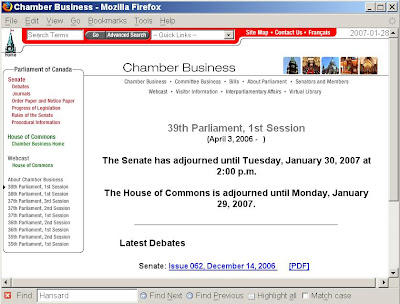
Parliament of Canada, Chamber Business webpage. For a full-size view, click on the image, or look at the original Chamber Business webpage.
Look at that navigation information in the left-side column:
About Chamber BusinessThis is a textbook example of the blinkered approach to site design that we see far too often in the government's websites. Does any citizen, who is looking for government information — say a Hansard report of a speech by his/her MP — think of the date of that speech in terms of 36th or 37th or 38th Parliament, 1st or 2nd or 3rd Session? Of course not. We the people think of such things in terms of calendar dates.
39th Parliament, 1st Session
38th Parliament, 1st Session
37th Parliament, 3rd Session
37th Parliament, 2nd Session
37th Parliament, 1st Session
36th Parliament, 2nd Session
36th Parliament, 1st Session
35th Parliament, 2nd Session
35th Parliament, 1st Session
Sure, these official Chamber Business documents are organized by Parliament and Session numbers, and the site navigation has to be organized in the same way, but the navigation should match these Parliament and Session numbers with calendar dates. These dates should appear in the navigation column — or at the very least as cursor hover popups (although hover popups are less satisfactory because different browsers react to them in different ways).
Below is an example of the much more useful (from a citizen's viewpoint) navigation offered by the Ontario Hansard Index

Ontario Hansard Index, showing Parliament and Session numbers with calendar dates. For a full-size view, click on the image, or look at the original Ontario Hansard Index.
26 January 2007
Parks Canada Website - A Citizen's View (9)
I know of two glaring historical errors that appear in the Parks Canada website. They've been there for years with no prospect of getting them straightened out.
Here's an excellent role model, that Parks Canada would do well to emulate — The Toronto Star newspaper gives prominence to The Bureau of Accuracy (see screenshot below), with a clear invitation to tell them about a mistake: "If you have information about an error that calls for a published correction, please" send an e-mail, or phone or fax, or mail a letter. An archive of recent corrections is available.

Toronto Star corrections webpage. For a full-size view, click on the image.
Here's another excellent role model, that Parks Canada would do well to emulate — CBC News Report a Typo or Inaccuracy
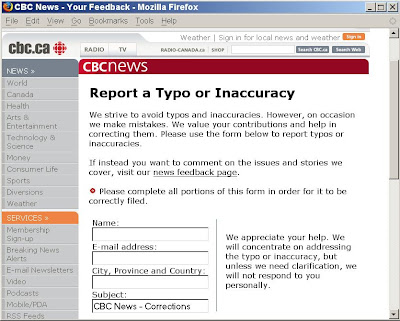
CBC News corrections webpage. For a full-size view, click on the image.
The only thing missing here is an archive of recent corrections, similar to that provided by the Toronto Star (above).25 January 2007
Treasury Board Website, Weak Design
This "enlarged" 886 × 734px image is far too tiny – most of the text, including what seems to be a list of the names of the 39 parks, is illegible because it is too small. In this full-size screenshot of the lower right corner of this "enlarged" image, can you read "Prince Edward Island"?

Full-size "enlarged" view
Here's another tiny "enlarged" image — in the same Treasury Board of Canada webpage "DPR 2005-2006, Parks Canada Agency" Section 2: Performance by Program Activities, when you scroll down, there is a small (450 × 357px) map "Figure 11: The 154 National Historic Sites of Canada Administered by Parks Canada, Click image to enlarge."
This "enlarged" 850 × 676px image is far too tiny – most of the text is illegible because it is too small. In this full-size screenshot of the lower right corner of this "enlarged" Parks Canada map, how much of the text can you read?

Full-size "enlarged" view
One of the basic principles in the design of any website, especially one prepared with taxpayers' money, must be that any map displayed online has to be available in a version sufficiently large that all of the place names on the map are legible. That's obvious, isn't it?
In the same page, this statement appears:
"Level of Awareness and Access to Best Practice Information: In 2004-2005, the Agency commissioned a survey of other owners of national historic sites (see Background Performance Information www.pc.gc.ca library for a more complete description of the survey and how to obtain a copy of the results)."
Yeah, right. Here's a challenge: Go to this www.pc.gc.ca library — please note that I've made it much easier for you to find this "library" by providing a link, something the well-paid government website designers should have done but didn't — and see how long it takes you to find this "Background Performance Information." On second thought, forget how long, and just try to find it. Hint: a search, using these three keywords Background Performance Information, returns this helpful message: "No documents matching your query were found." The designers of this webpage clearly have not bothered to enquire if this works for someone not on the inside.
In that same page, the geniuses in charge of this website design tell the citizen, 23 times in 23 separate paragraphs, to go to www.pc.gc.ca for more information. Not once have they provided a link directly to the recommended information, to help the citizen. I've not been able to find any of this supposed additional information. Is anyone minding the store at the Treasury Board website design office?
14 January 2007
Alberta's Online Encyclopedia
Northwest Territories Website - Unacceptable
"Site best viewed at 800 X 600 resolution."

This is an unacceptable approach to the design of a government website. Fewer than one in five computers now have screens as small as 800×600px (source).
Screen sizes in useWhat do they expect? Do they really think that each citizen who views this site should go out any buy a monitor (in the now nearly-unobtainable) small size 800 by 600 pixels?
Larger 1024x768 800x600
2006 Jul 19% 58% 17%
2006 Jan 17% 57% 20%
2005 Jul 14% 55% 25%
2005 Jan 12% 53% 30%
2004 Jul 10% 50% 35%
2004 Jan 10% 47% 37%
It is the responsibility of the website designer to see that any website operated by any government is designed to work properly with
(1) at least four or five of the most-used browsers, and
(2) several screen sizes, as are currently in use by citizens.
It is the responsibility of the department management to see that the site designer is meeting this requirement.
Parks Canada Website - A Citizen's View (8)
A much larger view of this magnificent sculpture should be available online. After all, this online information is available to many thousands of people who will never have the opportunity to visit The Forks National Historic Site in person.
There are numerous other small photographs in the associated pages of this website, that should be made available in a larger size.
13 January 2007
ParksCanada For Sale
Parks Canada Website - A Citizen's View (7)
Commemorative Plaque Models
Failed Validation, illegal characters

Failed validation report: HSMB page: Commemorative Plaque Models. For a full-size view, click on the image.
This faulty Parks Canada website is contrary to the Government's standards for website design.
11 January 2007
Parks Canada Website - A Citizen's View (6)
It returned a page showing thumbnails of photographs of monuments in Canada, with this note: "For a larger view...click on photo".
To see what the "larger view" looks like, I clicked on a thumbnail, "Rogers Pass Monument commemorating opening of Trans-Canada Highway, 1977".
The thumbnail is 150 pixels wide. The "larger view" option brings up a photo only 300 pixels wide. Just twice the size! This is so 1990s.
Like most people using the Internet these days, my screen is 1024 pixels wide. The "larger view" should be much larger than 300 pixels wide – that is if Parks Canada wants to show off its photo collection to advantage, making best use of the characteristics of the Internet as it exists today.
The "larger view" should be at least 700 pixels wide, and 900 would be better.
Parks Canada should take a close look at Wikipedia's excellent way of providing larger views of small thumbnail photos embedded in its articles. For example, see Wikipedia's Field Hill. This article includes a photograph (350×236 pixels) of the "View from the cab of a Canadian Pacific Railway locomotive at the 'Cathedral' signpost as it ascends the Big Hill." Immediately below this image, to the right of the caption, there is a standard graphic indicating that a larger image is available. Clicking on this graphic brings up a larger view (800×540px) of the same photograph. Immediately below this image, we see a link "Download high-resolution version...". Clicking on this link brings up an excellent full-screen view 1024×691px). All this is done using a single full-size image stored on the Wikipedia server, with the reduced sizes generated on demand, immediately before downloading.
Another example can be seen in Wikipedia's Cape Breton and Central Nova Scotia Railway. This article includes a photograph (300×127 pixels) "CB&CNSR freight train northbound on the Abercrombie spur." Immediately below this image, to the right of the caption, there is a standard graphic indicating that a larger image is available. Clicking on this graphic brings up a larger view (800×338px) of the same photograph. Immediately below this image, we see a link "Download high-resolution version...". Clicking on this link brings up an excellent full-screen view 1207×510px). Again, all this is done using a single full-size image stored on the Wikipedia server, with the reduced sizes generated on demand before downloading.
A third example can be seen in Wikipedia's List of national historic sites of Canada. This article includes a photograph (180×114 pixels) of the "Hartland Covered Bridge National Historic Site." Immediately below this image, to the right of the caption, there is a standard graphic indicating that a larger image is available. Clicking on this graphic brings up a larger view (800×508px) of the same photograph. Immediately below this image, we see a link "Download high-resolution version...". Clicking on this link brings up an excellent full-screen view 2048×1300px). Again, all this is done using a single full-size image stored on the Wikipedia server, with the reduced sizes generated on demand.
A fourth example (many hundreds are available) can be seen in Wikipedia's Athabasca Oil Sands. This article includes a photograph (300×127 pixels) of the "Minesite at Syncrude's Mildred Lake plant." Immediately below this image, to the right of the caption, there is a standard graphic indicating that a larger image is available. Clicking on this graphic brings up a larger view (800×600px) of the same photograph. Immediately below this image, we see a link "Download high-resolution version...". Clicking on this link brings up an excellent full-screen view 1024×768px). Again, all this is done using a single full-size image stored on the Wikipedia server, with the reduced sizes generated on demand.
(Later): A friend commented by e-mail: "That's all very well, but those large full-screen images have very large file sizes, and take too long to download" (he has a 56k dial-up connection).
My reply: Some of the full-screen images do have large file sizes, but if good photographic software is used to compress them properly, they can be kept within acceptable file sizes while maintaining high-quality on-screen images. For example, Parks Canada's larger view (above) of the Rogers Pass photo, a tiny 300×200px, occupies 74 kilobytes, compared to only 108 kilobytes for the full-size 1207×510px CB&CNSR photo (above). The full-size Mildred Lake photo (above) 1024×768px occupies only 135 kilobytes.
Addendum: January 17, 2007 16:35 UTC
Here's an example of a high-quality online rendition of an historic document, a superb archived copy 2417×3000px of an old map of Hillcrest Mines, Alberta.
Parks Canada Website - A Citizen's View (5)
It returned a page showing thumbnails of photographs. At the bottom this appeared: "Page 1 of 611". The only way provided, to look through the entire collection, was a "Next page" link. That is, if I want to see the thumbnails displayed on, say, page 567, I have to step through the whole collection, one page at a time, 1, 2, 3, 4, 5, 6, etc. until I get to page 567. This is, uh, an inadequate way to design a website.
It turned out that it is easy to get to page 567 or page 365 or page 99 or any other page in this collection, if you are willing and able to decipher and then edit the URL, but surely Parks Canada does not expect its viewers to do this. Surely they can provide a better way.
Parks Canada Website - A Citizen's View (4)
"In 1951, the Royal Commission on National Development in the Arts, Letters and Sciences noted the imbalance of the HSMBC's commemorative program and recommended that more attention be paid to preservation. In 1953, the Historic Sites and Monuments Act established the HSMBC by statute, enlarged it, and gave it increased resources. An amendment in 1955 specified the power to recommend national designation for buildings by reason of their age or architectural design. Thereafter, it studied more Canadian built heritage, expanding the concept to include streetscapes, districts, gardens, and urban and rural landscapes. With the introduction of the Heritage Railway Stations Act in 1989, the HSMBC was given the additional duty of evaluating Heritage Railway Stations. The Board continues to deal with the great number of requests for recognition of places, people and events in the various aspects of Canadian political, economic and social history..."
From a citizen's point of view, it would be a big help if this text included links (indicated by boldface type above) pointing toward additional information, such as, in the case of Acts, the Act text, etc.
10 January 2007
Parks Canada Website - A Citizen's View (3)
Two comments:
(1) This image is awfully dark. It should be modified with suitable photographic software to show a better (brighter) picture.
(2) There should be an option for the viewer to choose to see a larger image – large enough to use the available screen area to advantage. At this time, most Internet users have a screen 1024 by 768 pixels. A suitable image size for showing this Heritage Railway Station to advantage would be at least 700 pixels wide, and 900 would be better.
Parks Canada Website - A Citizen's View (2)
"The objective of the National Program for the Grave Sites of Canadian Prime Ministers is to ensure that the grave sites are conserved and recognized in a respectful and dignified manner. Another important objective of the program is to provide Canadians with information on the lives and accomplishments of each former prime minister, as well as the locations of their final resting places..."
"The following elements are part of the program: ...the establishment of a website with links to National Historic Sites of Canada that commemorate prime ministers, as well as to other prime ministers' web sites..."
In that text, the word "website" should be a link that takes the viewer to the website. Without this link, the "website" is impossible to find.
Parks Canada Website - A Citizen's View (1)
"Related Locations"
*Alexander Graham Bell National Historic Site of Canada
*Grassy Island Fort National Historic Site of Canada
*Cape Breton Highlands National Park of Canada
*Halifax Citadel National Historic Site of Canada
Clicking on any of these links produces an error message:
HTTP Error 404 - Not Found.
Parks Canada's website makes no provision for reporting a broken link.
04 January 2007
Parks Canada Ten Years Behind

Screenshot of Parks Canada website. "System Requirements... Browser: Netscape 7.2 or newer release." For a full-size view, click on the image.
Source: http://www.pc.gc.ca/apps/dci/source/install_ns.asp?langId=0&ref=http://www.pc.gc.ca/apps/dci/source/3d_e.asp?sitename=mar&theme=te&btn_state=%20Texte%20seulementNote that Parks Canada's screenshot examples are so small that they are illegible.
18 August 2006
New Brunswick Election Websites
Election Campaign Home Page
Failed Validation: 24 errors
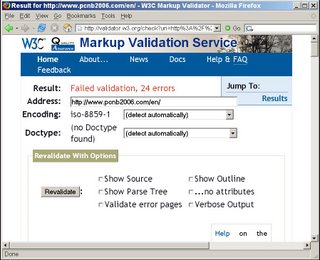
Failed validation report: New Brunswick Progressive Conservative Party 2006 election website home page. For a full-size view, click on the image.
Election Campaign Home Page
Failed Validation: 59 errors
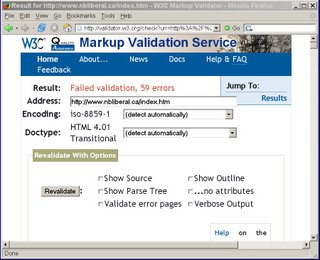
Failed validation report: New Brunswick Liberal Party 2006 election website home page. For a full-size view, click on the image.
Election Campaign Home Page
Failed Validation: 19 errors
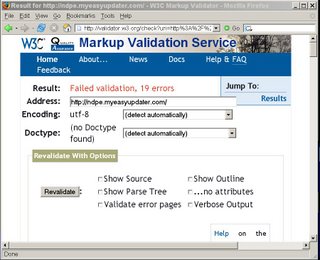
Failed validation report: New Brunswick New Democratic Party 2006 election website home page. For a full-size view, click on the image.
None of these three parties has seen fit to include a statement of their policies about website accessibility and/or interoperability. This omission provides, by itself, a revealing comment on the awareness, or lack thereof, of these party leaders with respect to the importance of such considerations in communicating with the public in 2006. If these standards are thought to be unimportant when they are fighting for public approval, is unlikely they will be given greater significance after the election is decided.
These validation tests were performed by using the W3C Validation Service.
09 June 2006
Prime Minister's Website
Example:
24 Sussex Drive
Failed Validation: 141 errors
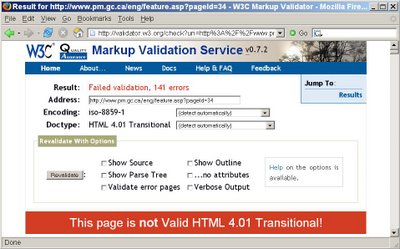
Failed validation report: 24 Sussex Drive page. For a full-size view, click on the image.
31 May 2006
Canadian Heritage Dept. Website
Example:
Heritage Day
Failed Validation: 59 errors
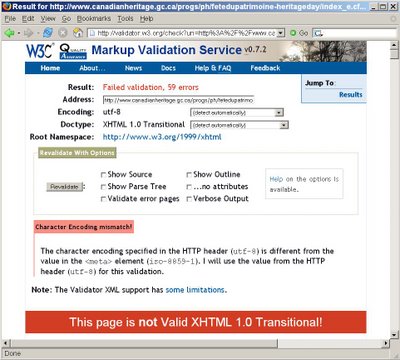
Failed validation report: Heritage Day page. For a full-size view, click on the image.
More:
Home Page
Failed Validation: 17 errors
Canada Day
Failed Validation: 6 errors
Celebrate Canada Committees
Failed Validation: 19 errors
Canada Day Poster Challenge
Failed Validation: 8 errors
Minister of Canadian Heritage and Status of Women
Successful Validation
Deputy Minister of Canadian Heritage
Failed Validation: 13 errors
19 May 2006
Nova Scotia Election Websites
Election Campaign Home Page
Failed Validation: 13 errors
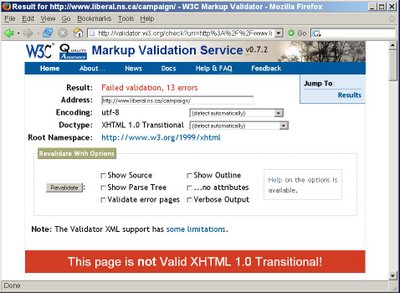
Failed validation report: Nova Scotia Liberal Party 2006 election website home page. For a full-size view, click on the image.
Election Campaign Home Page
Failed Validation: 21 errors
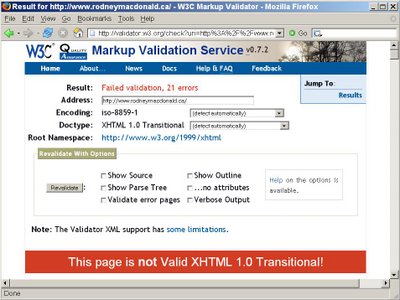
Failed validation report: Nova Scotia Progressive Conservative Party 2006 election website home page. For a full-size view, click on the image.
Election Campaign Home Page
Failed Validation: 202 errors
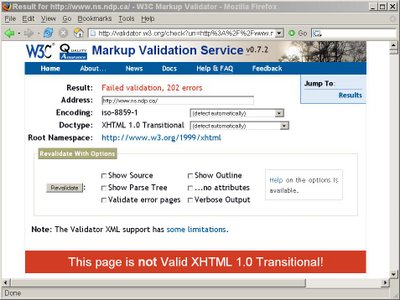
Failed validation report: Nova Scotia NDP 2006 election website home page. For a full-size view, click on the image.
None of these three parties has seen fit to include a statement of their policies about website accessibility and/or interoperability. This omission provides, by itself, a revealing comment on the awareness, or lack thereof, of these party leaders with respect to the importance of such considerations in communicating with the public in 2006. If these standards are thought to be unimportant when they are fighting for public approval, is unlikely they will be given greater significance after the election is decided.
These validation tests were performed by using the W3C Validation Service.
"It is highly recommended that X/HTML coding be checked by running all documents through an X/HTML syntax checker. Style sheets should be checked with the free W3C online validator."
This statement, including the links, is quoted directly from the Nova Scotia Government's Website Design and Content Standards. The validation recommended by this government standard is the W3C Validation Service, the same one I used to test these political party websites.BTW, the Nova Scotia Government's Website Design and Content Standards page validates successfully.
Addendum: May 22, 2006 11:23 UTC
This is a government website. Elections Nova Scotia is completely ignoring the government website standards.
Elections Nova Scotia Home Page
Failed Validation: 38 errors
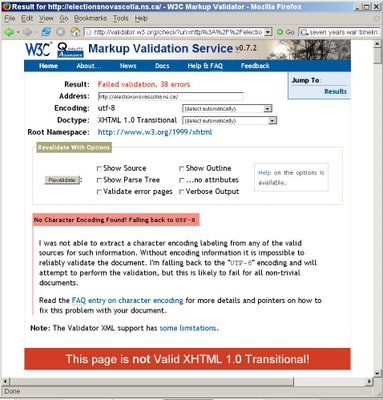
Failed validation report: Elections Nova Scotia website home page. For a full-size view, click on the image.
More:
Candidates and Parties
Failed Validation: 35 errors
Results and Stats
Failed Validation: 34 errors
Voter Information
Failed Validation: 35 errors
FAQ Page
Failed Validation: 60 errors
Electoral District Finder
Failed Validation: 61 errors
Here's an example of a government page that is designed without consideration of how it will work for the viewing citizen:
Map of Electoral District #2, Antigonish
The only reason for providing this map in pdf format is the convenience of the webmaster; if the interest of the citizen viewer was taken into consideration pdf would not be the choice.
10 May 2006
What Is a Good Government Website?
— Source: Quality Framework for UK Government Website Design
Invalid Pages: Public Safety (PSEPC)
Example:
A-Z Index
Failed Validation: 78 errors
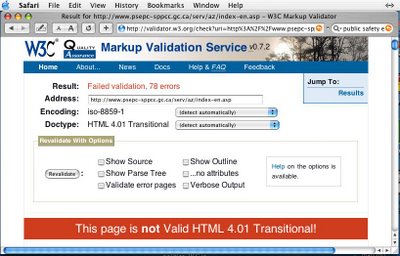
Failed validation report: PSEPC page: A-Z Index. For a full-size view, click on the image.
Example:
Department Organization
Failed Validation: 82 errors
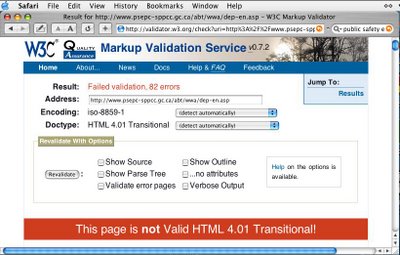
Failed validation report: PSEPC page: Department Organization. For a full-size view, click on the image.
Example:
First Responders
Failed Validation: 74 errors
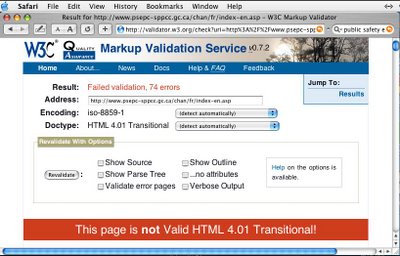
Failed validation report: PSEPC page: First Responders. For a full-size view, click on the image.
Example:
Basic rescue skills
Failed Validation: 83 errors
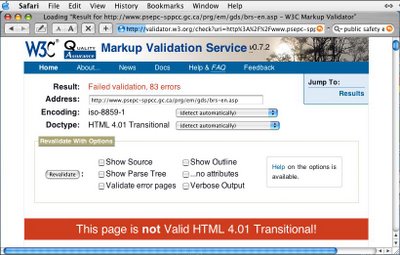
Failed validation report: PSEPC page: Basic rescue skills. For a full-size view, click on the image.
Example:
Citizens
Failed Validation: 74 errors
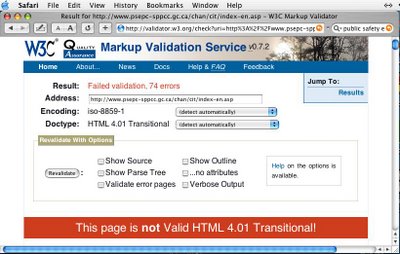
Failed validation report: PSEPC page: Citizens. For a full-size view, click on the image.
Example:
Site Map
Failed Validation: 13057 errors
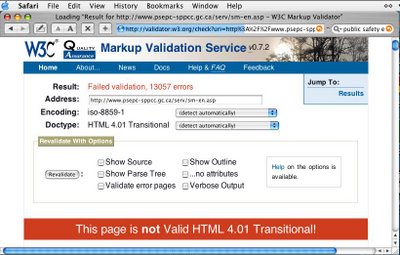
Failed validation report: PSEPC Site Map. For a full-size view, click on the image.
These validation tests were performed by using the W3C Validation Service.
08 May 2006
Invalid Pages: CBC
Example:
Failed Validation: 200 errors
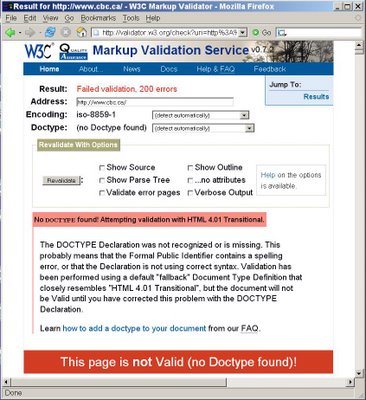
Failed validation report: CBC home page. For a full-size view, click on the image.
Example:
Failed Validation: 185 errors
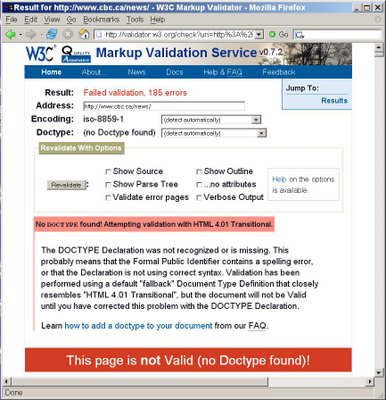
Failed validation report: CBC News page. For a full-size view, click on the image.
Example:
Failed Validation: 93 errors
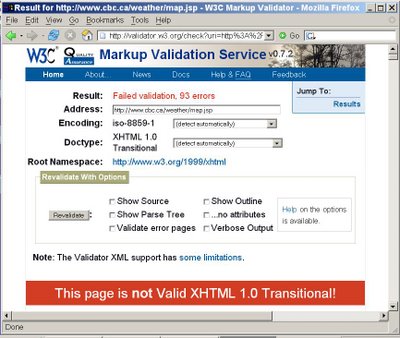
Failed validation report: CBC Weather page. For a full-size view, click on the image.
Example:
Failed Validation: 193 errors
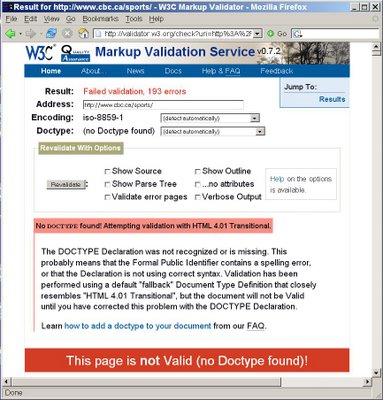
Failed validation report: CBC Sports page. For a full-size view, click on the image.
Example:
Personalities A-Z Index
Failed Validation: 565 errors
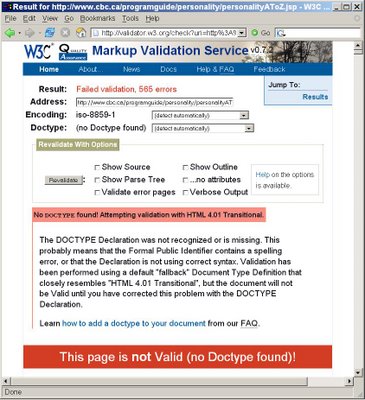
Failed validation report: CBC Personalities A-Z Index page. For a full-size view, click on the image.
Example:
Canadian Satellites
Failed Validation: 318 errors
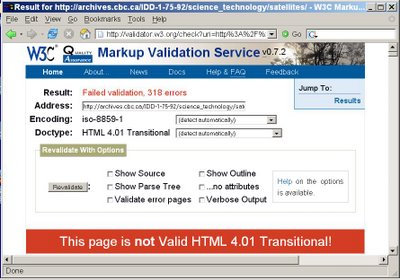
Failed validation report: CBC Archives — Canadian Satellites page. For a full-size view, click on the image.
Example:
Science and Technology
Failed Validation: 691 errors
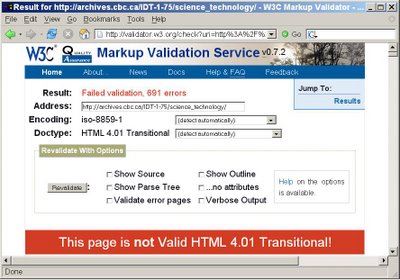
Failed validation report: CBC Archives — Science and Technology page. For a full-size view, click on the image.
These validation tests were performed by using the W3C Validation Service.
Invalid Page: House of Commons
Example:
Failed Validation: 38 errors
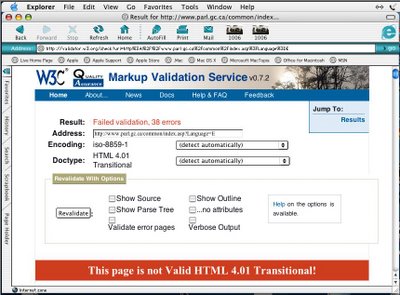
Failed validation report: Welcome to the Parliament of Canada page. For a full-size view, click on the image.
This validation test was performed by using the W3C Validation Service.
06 May 2006
Valid Page: Government of Canada
Home Page
Successful Validation
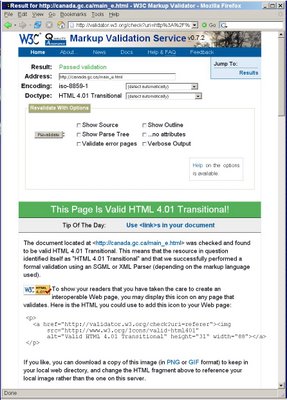
Successful validation report: Government of Canada home page. For a full-size view, click on the image.
This validation test was performed by using the W3C Validation Service.
05 May 2006
Invalid Page: Library and Archives Canada
Example:
Canadian Confederation Bibliography
Failed Validation: 815 errors
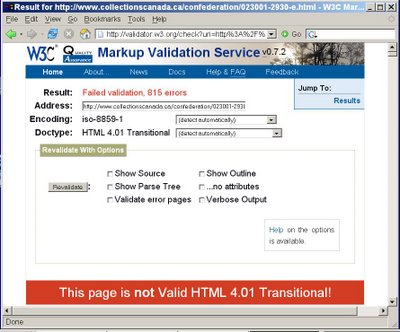
Failed validation report: Library and Archives Canada, Confederation Bibliography. For a full-size view, click on the image.
These validation tests were performed by using the W3C Validation Service.
04 May 2006
Invalid Pages: Finance Dept., Ottawa
Example:
Home Page
Failed Validation: 23 errors
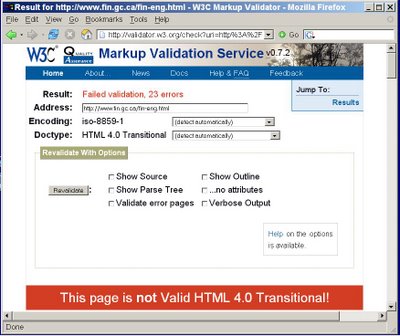
Failed validation report: Department of Finance home page. For a full-size view, click on the image.
Example:
The Honourable James M. Flaherty, P.C., M.P.
Minister of Finance
Failed Validation: 2 errors
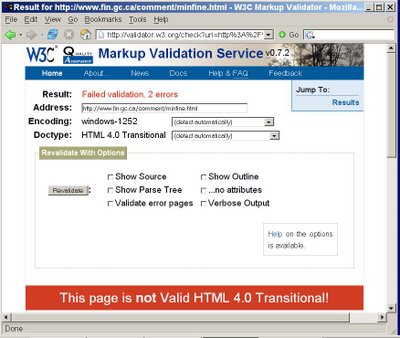
Failed validation report: Department of Finance, Minister's page. For a full-size view, click on the image.
Example:
Diane Ablonczy Parliamentary Secretary
to the Minister of Finance
Failed Validation: 5 errors
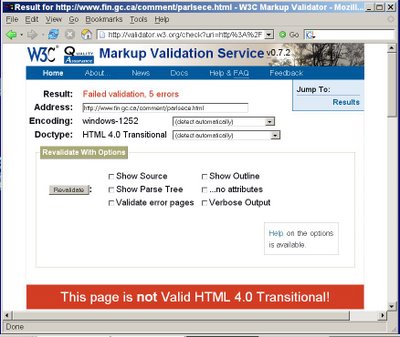
Failed validation report: Department of Finance, Parliamentary Secretary's page. For a full-size view, click on the image.
Example:
Deputy Minister Ian E. Bennett
Failed Validation: 3 errors
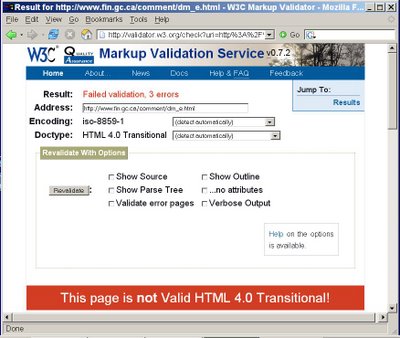
Failed validation report: Department of Finance, Deputy Minister's page. For a full-size view, click on the image.
Example:
Accessibility, Design Standards
Failed Validation: 9 errors
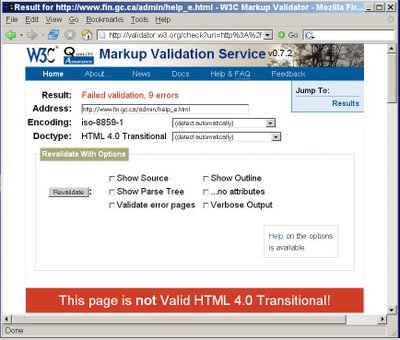
Failed validation report: Department of Finance, Accessibility, Design Standards page. For a full-size view, click on the image.
Example:
FAQ
Failed Validation: 80 errors
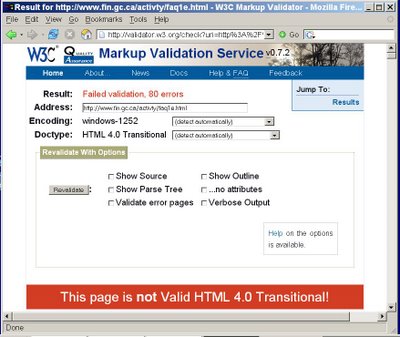
Failed validation report: Department of Finance, FAQ page. For a full-size view, click on the image.
These validation tests were performed by using the W3C Validation Service.
Here's another problem in this Department of Finance website.
In the Accessibility, Design Standards page, this statement appears: "The Finance Canada WWW site has been designed...for use with a computer screen resolution of 800×600 pixels."
Data gathered over the last six months, at three websites with a total traffic of 76,600 viewers, yielded the following statistics on monitor screen sizes in use at this time:
Width × height (in pixels)The 800×600 screen, favoured by the Department of Finance as its standard for the purpose of designing its website, is now used by less than one-third of Internet viewers. By this arbitrary decision, the Department of Finance has cavalierly brushed aside more than two-thirds of Canada's population. Any taxpayer-funded website should work properly when viewed with any monitor screen from a width of 800 pixels to 1280 pixels.
800×600 29%
1024×768 64%
1152×864 1%
1280×1024 6%
And there's yet another problem with the Department of Finance's approach to website design. In the Accessibility, Design Standards page, this statement appears: "The Finance Canada WWW site has been designed for use with MS Internet Explorer version 4 or more recent and Netscape version 4.7 or more recent."
Precise browser statistics are impossible to obtain, but the following are believed to be reasonably representative figures for the WWW at this time:
IE 75%The Department of Finance policy to design its website to work with Netscape, while ignoring Firefox, Safari and Opera, is at least five years behind the times. It cannot be defended today. Any taxpayer-funded website should work properly when viewed with any of the most-used browsers — IE (for both PC and Mac), Netscape, Firefox, Safari and Opera, at least.
Firefox 9%
Safari 5%
Opera 3%
Mozilla 2%
Netscape 1%
These do not add to 100% because other browsers
exist and are used to some extent.
This is easy to accomplish — design your website to meet the W3C standards, and then all browsers that comply with these standards (as all good browsers should) will display your website properly. This is the reasoning behind the Canadian Government's policy requiring that: "All GoC Web sites must comply with W3C Priority 1 and Priority 2 checkpoints to ensure sites can be easily accessed by the widest possible audience." This is the reason I've tested these GoC pages with the W3C Validator. This is the reason these GoC pages should not contain validation errors.
03 May 2006
Invalid Pages: Library of Parliament
That's a total of 5003 webpages, in this "Federal Political Experience" section alone, and each of these contains dozens of errors.
Example:
Federal Political Experience
Harper, The Right Hon. Stephen Joseph
Failed Validation: 28 errors
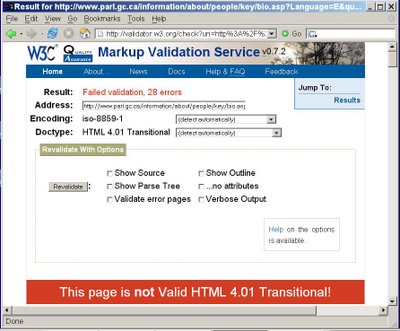
Failed validation report: Library of Parliament webpage Federal Political Experience, The Right Hon. Stephen Joseph Harper. For a full-size view, click on the image.
Example:
Federal Political Experience
MacKay, The Hon. Peter Gordon
Failed Validation: 28 errors

Failed validation report: Library of Parliament webpage Federal Political Experience, The Hon. Peter Gordon MacKay. For a full-size view, click on the image.
Example:
Index Page
Members of the House of Commons
1867 to Date, By Name – Z...
Failed Validation: 213 errors
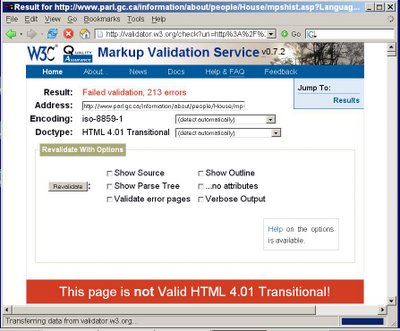
Failed validation report: Library of Parliament Index Page Z, Members of the House of Commons, 1867 to 2006. For a full-size view, click on the image.
Example:
Index Page
Members of the House of Commons
1867 to Date, By Name – A...
Failed Validation: 433 errors
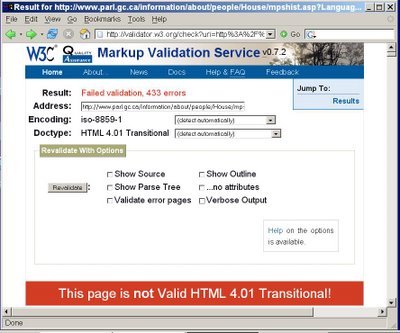
Failed validation report: Library of Parliament Index Page A, Members of the House of Commons, 1867 to 2006. For a full-size view, click on the image.
All of these Library of Parliament webpages have been updated in the last four months, thus should be fully compliant with the latest government standards for website design.
These validation tests were performed by using the W3C Validation Service.
Here's another problem in these Library of Parliament pages.
Each of the MP index pages has this near the top:
"To view the federal political experience of a Member of the House of Commons, click on one of the underlined names listed below."
Problem: There are no "underlined names below". There are lots of names, but none are underlined.
Members of the House of Commons
1867 to Date, By Name – S...
Each of the Senator index pages has this near the top:
"To view the federal political experience of a Senator, click on one of the underlined names listed below."
Problem: There are no "underlined names below". There are lots of names, but none are underlined.
Senators, 1867 to Date By Name
22 April 2006
The Early Days of the WWW
Websites that were brand new in the mid-1990s, the Early Days, are now celebrating their tenth anniversaries.
Fourteen weeks ago, on January 15, 2006, Transport Canada celebrated its 10th year on the web. This celebration webpage includes screenshots of archived copies of the website in its early days, including one showing its appearance in August 1997 (displayed in the Microsoft Internet Explorer browser, which did not exist at that time).
Here's the appearance of the Transport Canada website in November 1996, as displayed in Netscape, the dominant browser of that time.
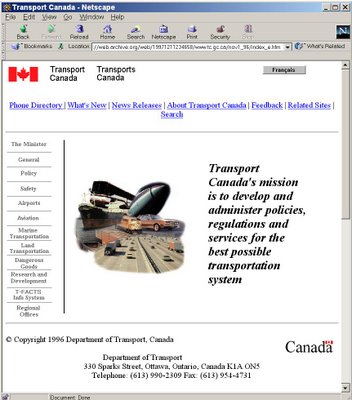
The Transport Canada website in the early days. This image was archived on December 11, 1997, but this design was online from November 1, 1996. For a full-size view, click on the image.
Archived Websites — 1996 or Earlier
Security Policy-Manager's HandbookTreasury Board of Canada
September 27, 1996
Government of Newfoundland and Labrador
October 22, 1996
October 27, 1996
December 22, 1996
Government of Prince Edward Island
October 22, 1996
October 27, 1996
December 19, 1996
Government of Manitoba
October 22, 1996
October 27, 1996
December 22, 1996
Government of Nova Scotia
October 22, 1996
October 27, 1996
"This site has been optimized for Netscape Navigator® version 2.0 or equivalent."
National Archives of Canada
October 29, 1996
Government of Saskatchewan
November 5, 1996
December 22, 1996
World-Wide Web Access Statistics for Saskatchewan Government website December 1996
Huron Public Education System, Huron County, Ontario
November 6, 1996
Huron Public Education System Web Site Archives
November 6, 1996
"This site best viewed with Netscape version 2.0 or greater."
Queen's Printer, British Columbia
December 18, 1996
"This page has been accessed 16,811 times since June 19, 1996."
York Region Board of Education, Ontario
December 18, 1996
 "This page is best-viewed with Netscape 2.0..."
"This page is best-viewed with Netscape 2.0..."Prime Minister's home page
December 21, 1996
Department of Veterans Affairs, Ottawa
December 22, 1996
Canada's Climate Change Voluntary Challenge and Registry
December 26, 1996
Department of Indian and Northern Affairs, Ottawa
December 29, 1996
Canadian Space Agency
December 30, 1996
The above are the dates on which the earliest known copies were archived, and are not the dates these websites first appeared online.
Websites — Earliest Known Archived Copy 1997
Government of British ColumbiaJuly 8, 1997
Ontario Ministry of Education
December 10, 1997
 "This site is best viewed using Netscape Navigator, which supports a large set of HTML extensions, some of which have been used in documents located here. Netscape browsers are available free of charge to students, staff, and faculty members of education institutions, charitable non-profit organizations, and public libraries."
"This site is best viewed using Netscape Navigator, which supports a large set of HTML extensions, some of which have been used in documents located here. Netscape browsers are available free of charge to students, staff, and faculty members of education institutions, charitable non-profit organizations, and public libraries."Websites — Earliest Known Archived Copy 1998
Government of Quebec (for screen 640×480 pixels)January 28, 1998
Central Index of Canadian WWW Servers
Archive copy dated: December 5, 1998
Webpage dated: January 18, 1995